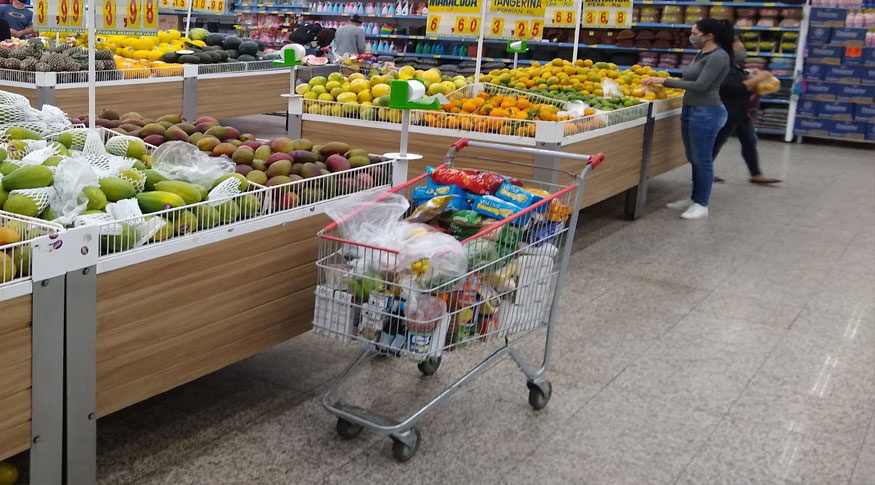IPCA
Gasoline and food products lead inflation rise of 0.24% in August
September 09, 2020 09h00 AM | Last Updated: September 09, 2020 10h54 PM

Inflation had not reached sucha a high figure in a month of August since 2016, although the index (0.24%) decelerated against July (0.36%). Expensive items for consumers were gasoline, which recorded an increase for the third straight month, and food products, which reachd some stability in July, but rose again in August. For lower income families, the impact was even bigger.
Data was released today (9) by the IBGE and form the Extended National Consumer Price Index (IPCA), which refers to families with an income of one to 40 minimum wages. In the year, the indicator recorded a cumulative increase of 0.70% in the year, and of 2.44% in 12 months.
The National Consumer Price Index (INPC), which refers to families with an income of one to five minimum wages, rose 0.36% in August, and recorded the highest result for the month since 2012 (0.45%). In the year, the INPC had a cumulative increase of 1.16%, and in the last 12 months, of 2.94%.
“The most relevant item (4.67% of the total) to the IPCA is gasoline (3.22%), which caused Transportation (with an increase of 0.82%) to account for the biggest negative impact on the August index. The second main contribution came from Food and beverages (0.78%). Regarding INPC, which is an index aimed at lower-income families, food products (with an increase of 0.80% in August) is the most significant item, and has recorded an increase above the IPCA in the year,” Pedro Kislanov, manager of the survey, explains, as he highlights that food products represented 20.05% of the IPCA and 22.82% of the INPC.
Food at home recorded an increase of 1.15% in August. The main items accounting for that increase were tomato (12.98%), soybean oil (9.48%), long life milk (4.84%), fruits (3.37%) and beef (3.33%). The hikes of basic food items for nutrition in Brazil, such as rice and beans, may increase inflation perception at supermarkets.
“Rice (with 3.08% in August) had a cumulative increase of 19.25% in the year and beans, depending on the type and region, recorded inflation above 30%. Black beans, an item commonly consumed in Rio de Janeiro, had a cumulative increase of 28.92% in the year and pinto beans, of 12.12%,” Mr. Kislanov highlights.
On the other hand, food away from home (-0.11%) remains on a downward trend, although at a lower rate than in the previous month (-0.29%).
Deflation also affected wearing apparel (-0.78%), even more significantly than in July (-0.52%). There were decreases in the prices of men’s apparel (-0.74%), women’s apparel (-1.23%) and children’s apparel (-1.46%), besides footwear and accessories (-0.55%).
On the other hand, the main item holding inflation down was Education (-3.47%), since many teaching establishments started to apply discounts in their fees during the isolation period due to the Covid-19 pandemic, due to the suspension of face to face class. The prices of regular courses fell by 4,38%; pre-school (-7.71%) recorded the main decrease, followed by graduate courses (-5.84%), youth and adult education (-4.80%) and daycare centers (-4.76%).
In terms of Housing, however, there was increase (0.36%). The biggest impacts came from residential rent (0.32%) and electricity (0.27%). It is also worth mentioning the rise of prices of some construction material, such as bricks (9.32%) and cement (5.42%), which had risen in July (4.13% and 4.04%, respectively).
Deflation was present in five areas surveyed
Deflation was observed in five of the 16 areas surveyed in August. The lowest index was that of Aracaju (-0.30%), mainly due to the reduction of costs of regular courses (-7.27%). The other areas with negative IPCA figures were Fortaleza (-0.23%), Rio de Janeiro (-0.13%), Belém (0.04%) and Vitória (0.03%).
The highest positive result, in turn, was that of Campo Grande (1.04%), mainly due to the rise of some food products, such as beef (6.28%) and fruits (9.54%). Other seven areas were above the national average (0.24%): Goiânia (0.66%), Brasília (0.58%), Rio Branco (0.54%), Recife (0.46%), São Luís (0.38%), Porto Alegre (0.33%) and São Paulo (0.31%).
Regarding the INPC, only two of the 16 areas surveyed recorded deflation, Fortaleza (-0.16%) and Aracaju (-0.23%). And ten Major Regions had inflation above the average of 0.36%, with the highest rates being those of Campo Grande (1.33%), with a rate almost three times higher, Brasília and Rio Branco, both with a rate almost two times higher (0.71%).


















